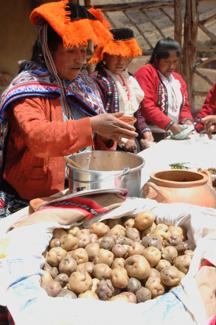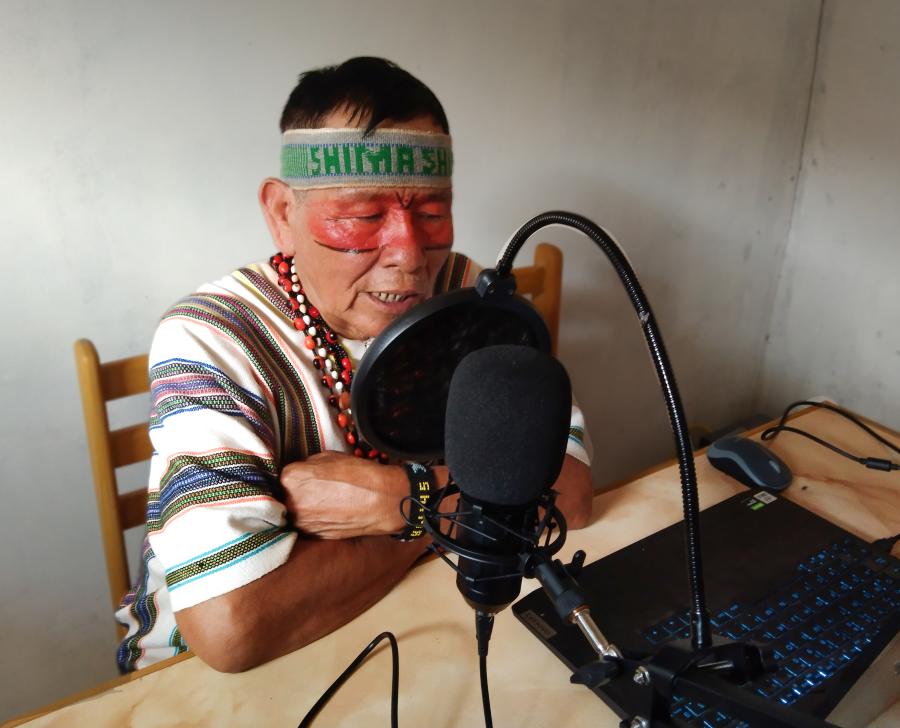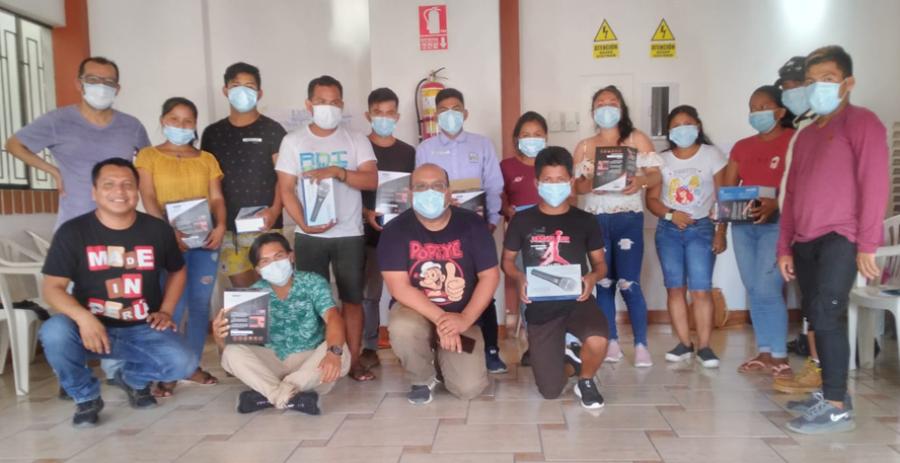At four the morning, Quechua farmers in the high altitude Andean communities of Amaru and Paru Paru, Peru are beginning the day in their fields, or chacras. Most of them are tending to a crop representative of the Quechua diet and culture: the potato. “Our most basic food is the native potato,” says Isabella, a Quechua woman and respected elder from Amaru.
In nearby Paru Paru, Lino Mamani Huarka and his family grow between 120 and 140 native potato varieties. This is only a small portion of the varieties that exist within Peru; more than 2,800 types are known to have originated in the country. The existence of these varieties can be attributed to the high value the Quechua people place on their cultural traditions and biological diversity.
There are nearly as many uses for potatoes as there are varieties, from food preparation to the treatment of illness, and for use in various cultural practices. “In the countryside, we do not have many illnesses because there are different types of potato for every sickness,” says Isabella. Not only are potatoes important to the health of Quechua communities (they contain a high level of antioxidants), they are also a valuable commodity for trade. Farmers living in higher altitudes where potatoes are cultivated trade the tuber for crops growing in lower altitudes, such as quinoa and corn.
In maintaining a wide variety of potatoes, the Quechua have also protected their people from widespread agricultural disaster. Due to the diversification of their most important crop, there has been no recorded agricultural disaster akin to the Irish Potato Famine of the 1880s in their society.
The potato also plays an important role in multiple Quechua cultural traditions, including marriage. In many communities, if a man wants to marry a woman, the man’s mother presents her with a potato named for its ability to “make the daughter-in-law cry.” The daughter-in-law must carefully peel the knobby tuber, which resembles a pine cone in shape. If she removes more than is necessary, she will not be allowed to marry the woman’s son.
Another cultural pillar in Andean Quechua communities is the ceremony surrounding potato planting and harvesting. These rituals are a traditional way of showing respect to the earth and to the crops that sustain these communities, and almost always involve an offering to Pachamama, or Mother Earth. Isabella explains the ritual associated with her farm work, “Before we work, we give thanks to the Pachamama with coca leaves.” This ceremony, called quintu, involves multiple sets of three coca leaves, which are combined with llama fat and placed into the first hole where potatoes are to be planted.
While there are hundreds of potato varieties which differ in appearance, texture, and flavor, most fall into four traditional categories. Chuño potatoes are prepared through a freezedrying method in which they are laid out in the coldest months of the year, covered with frost overnight, and exposed to direct sunlight during the day, dehydrating and turning them black. Once prepared this way, the potatoes can be stored for 10–15 years, or longer. The moraya potato is similar to chuño, but is freeze-dried in running water and then washed until the starches are gone, leaving the potato white. A third type is reserved for soups or dishes where peeled and cut potatoes are needed. Potatoes reserved for watya are boiled whole with the skin or cooked using the watya process, in which
a small wood-fueled oven is made in the earth and potatoes are added as hot earth is pushed in around them for cooking.
One organization working to protect potato biodiversity in Peru is the Parque de la Papa or Potato Park in Pisaq, Cusco. The Park is an Indigenous biocultural territory comprised of six Quechua communities dedicated to protecting their land, local native potato varieties, and culture. Formed in 1998, with the help of ANDES, the Association for the Environment and Sustainable Development (Associacion Para la Naturaleza y el Desarrolo Sostenible), the area is a government-recognized park where 1,400 varieties of potato are grown. These varieties were compiled through local gathering, donations from the International Center for the Potato (CIP, Centro International de la Papa), the town of Ayacutro, and members of a native potato network. The Park is run by its members, who have made strides in biodiversity conservation.
Biopiracy, or the illegal commercialization of biological materials, is one of many threats to the conservation of native potato varieties. Lino Mamani from Paru Paru works with a subgroup of the Potato Park called the Papa Arariwa, or “Guardians of the Potato.” He works on the technical side of potato conservation, using charts and a computer database to keep track of the different varieties brought to the Park. He also tracks where these varieties are planted and any special care they may need. Lino says that this process “is also a way of protecting against pirates who might come and try to take ownership of some of [the Park’s] varieties that have been maintained for years.”
Climate change is another risk to potatoes, and the region has recently experienced extreme weather events including hail, snow, and frost during what are typically the summer months. These extremes have threatened both the crops and the people of this region. The Potato Park has consulted with elders of these communities to design adaptation strategies for such events, and members of the Park have begun producing seeds from potatoes; potatoes have traditionally been cultivated using the whole tuber. The seeds generated from the native tubers are then sent to the Svalbard Global Seed Vault in Norway. “You never know what could happen in the Park,” says Tammy Stenner, education coordinator at ANDES. “You could lose those varieties, and [seed propagation] is a way of saving those seeds in case they are needed in the future.”
Members of the Potato Park have affected legislation regarding another threat to potato biodiversity in Peru: genetically modified organisms, or GMOs. Members of the Park recently traveled to Lima to participate in protests against the country’s acceptance of GMOs into Peru’s markets. Park member Ricardo Paccu Chipa of Paru Paru says of GMOs, “It’s very important that the world realizes these risks.” Risks include biodiversity loss and an increased vulnerability to plant diseases. Peru agreed to a 10-year moratorium on the import of genetically modified crops in order to study their risks and benefits, another step towards conserving the biological and cultural diversity of Peru.
Quechua farmers and those participating in the Potato Park are helping to ensure that native varieties continue to be cultivated for generations to come. The participation and devotion of each member of these communities has made the conservation of these varieties successful. With so many individuals dedicated to the maintenance of Peru’s biodiversity, local native potatoes are in good hands. Lino Mamani puts it best when he says, “We are all Papa Arariwas, Guardians of the Potato.
Amanda Stephenson is a former Cultural Survival intern. This article is based on an interview with members of the Potato Park, coordinated by ANDES staff member Tammy Stenner.




